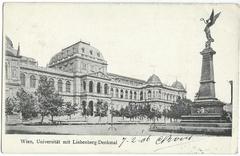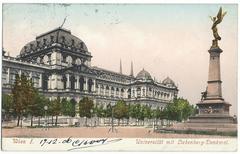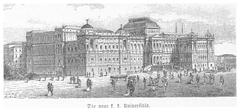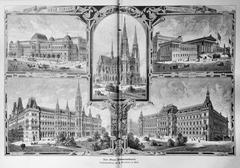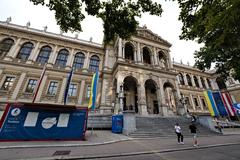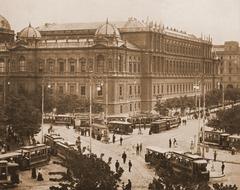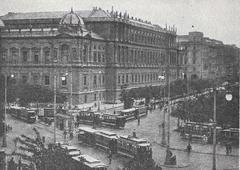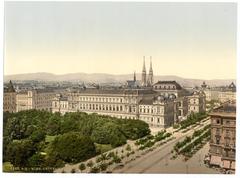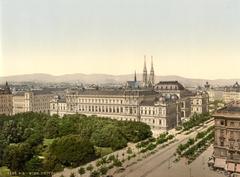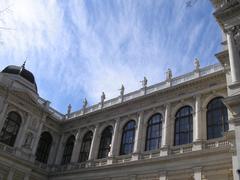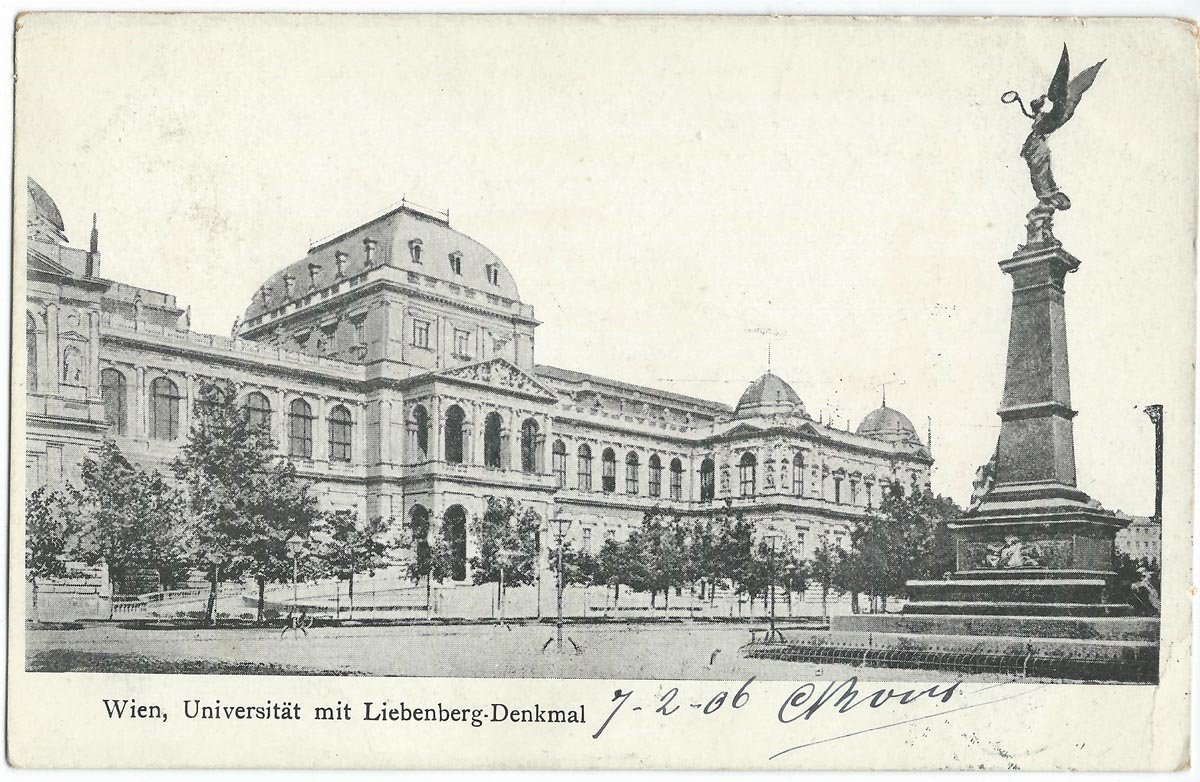
University of Vienna Main Building: Visiting Hours, Tickets, and Historical Information
Date: 15/06/2025
Introduction
The University of Vienna Main Building is a landmark of academic excellence, architectural splendor, and cultural heritage in central Vienna, Austria. Since its founding in 1365 by Duke Rudolf IV, the University of Vienna has been the oldest in the German-speaking world and one of Europe’s most prestigious institutions. The Main Building, constructed between 1873 and 1884 by architect Heinrich von Ferstel, exemplifies Historicist architecture inspired by the Italian Renaissance. It features grand arcades, Corinthian columns, and the expansive Arkadenhof courtyard adorned with busts of eminent scholars such as Sigmund Freud and Erwin Schrödinger.
This guide offers comprehensive information for visitors, including opening hours, ticketing, guided tours, accessibility details, travel tips, and the building’s historical and cultural significance. Whether your interests lie in history, architecture, or the vibrant academic atmosphere, the Main Building is a must-visit destination on Vienna’s iconic Ringstraße, alongside the Vienna State Opera, City Hall, and other major attractions.
For the latest visitor information and updates, consult the official University of Vienna resources (University of Vienna Visitor Information), and the venue management pages (University of Vienna Venue Management).
Contents
- Historical Overview
- Architectural Style and Design Principles
- Exterior Features
- Façade and Main Entrance
- The Arcaded Courtyard (Arkadenhof)
- Interior Highlights
- Aula (Assembly Hall)
- Grand Staircases
- Main Ceremonial Hall (Großer Festsaal)
- University Library and Reading Room
- Commemorative and Artistic Elements
- Functional Innovations
- Integration with the Ringstraße
- Visiting Hours and Ticket Information
- Guided Tours and Special Exhibitions
- Accessibility
- How to Get There
- Nearby Attractions
- Photographic Spots
- Visitor Tips and Practical Information
- Preservation and Modern Use
- Academic and Cultural Significance
- FAQ
- Plan Your Visit
- Visual and Interactive Resources
- Explore More
- References
Historical Overview
Founded in 1365 by Duke Rudolf IV, the University of Vienna is the oldest university in the German-speaking world (University of Vienna). The Main Building, completed in 1884 and designed by Heinrich von Ferstel, is a testament to the ideals of humanism, scholarship, and the pursuit of knowledge. Its construction was part of the grand Ringstraße project, which reshaped Vienna in the late 19th century with monumental public buildings (University of Vienna history).
Architectural Style and Design Principles
The Main Building is a prime example of Historicist architecture in the Italian Renaissance Revival style. Ferstel’s design incorporates a symmetrical façade, open arcades, and a prominent gable with the inscription “Universitas Litterarum Vindobonensis.” The proportions and decorative elements are reminiscent of Renaissance palazzi, symbolizing Vienna’s commitment to learning and culture (venue management).
Exterior Features
Façade and Main Entrance
The Ringstraße-facing façade features open arcades, robust columns, and classical ornamentation. The entrance is crowned by a relief of “the birth of Minerva,” signifying wisdom and the university’s dedication to knowledge. The light-colored stone integrates the building with other Ringstraße monuments (Vienna Info).
The Arcaded Courtyard (Arkadenhof)
The Arkadenhof is one of Europe’s largest arcaded courtyards, inspired by Italian “Campo Santo” designs. It is surrounded by columns and arcades, with over 150 busts and monuments honoring scholars like Freud, Schrödinger, and Popper. The centerpiece is the Castalia Fountain, which also functions as part of the original heating and ventilation system (visitingvienna.com, geschichte.univie.ac.at).
Interior Highlights
Aula (Assembly Hall)
The Aula serves as the ceremonial and gathering space, featuring marble floors, high ceilings, and plaques listing all university rectors since 1365 (guided tours).
Grand Staircases
The Juristenstiege and Philosophenstiege staircases are architectural highlights, adorned with marble and decorative sculptures. They lead to ceremonial halls and the library (geschichte.univie.ac.at).
Main Ceremonial Hall (Großer Festsaal)
The Main Ceremonial Hall hosts graduations, honors ceremonies, and academic events. It is decorated with statues of Duke Rudolf IV and Empress Maria Theresa and features artwork by Franz Matsch after designs by Gustav Klimt (event.univie.ac.at, wien.info).
University Library and Reading Room
The main library is among the oldest academic libraries in the German-speaking world, with a vaulted ceiling, arched windows, and an inspiring study environment (bibliothek.univie.ac.at).
Commemorative and Artistic Elements
The Arkadenhof and corridors display busts and plaques commemorating Nobel laureates and influential academics, turning the building into a living museum (visitingvienna.com). Artistic details, including ceiling paintings and reliefs, reflect Ferstel’s vision of a space that inspires reverence and intellectual curiosity (geschichte.univie.ac.at).
Functional Innovations
The Castalia Fountain in the Arkadenhof serves both as a decorative centerpiece and as part of the original ventilation system. The Auditorium Maximum (AudiMax), Austria’s largest lecture hall, accommodates up to 750 people and is used for lectures and major events (event.univie.ac.at).
Integration with the Ringstraße
The Main Building’s location on the Ringstraße situates it among Vienna’s most important landmarks, contributing to the city’s cohesive architectural narrative alongside the State Opera, Parliament, and City Hall (timeout.com).
Visiting Hours and Ticket Information
- Opening Hours: Monday to Friday, generally from 8:00 AM to 6:00 PM. Some areas may be closed during holidays or private events. Weekend access is possible during special events. Always check the official University website for current hours.
- Tickets: Entry to the Main Building and Arkadenhof is free. Guided tours and special exhibitions may require tickets, which can be reserved online or at the visitor center.
Guided Tours and Special Exhibitions
Guided tours, available in several languages, provide in-depth insights into the building’s history, architecture, and notable figures. Tours often include ceremonial halls, the Arkadenhof, and the library (Vienna Info). Details and booking are available on the university website.
Accessibility
The building is wheelchair accessible, with ramps, elevators, and accessible restrooms. Assistance is available upon request (University of Vienna Services).
How to Get There
- Address: Universitätsring 1, 1010 Vienna
- Trams: Lines D, 1, 71, 43, 44 to “Schottentor”; Lines 1, 2, D, 71 to “Dr.-Karl-Renner-Ring”
- Subway: U2 to “Schottentor”
- Bike: Cycling paths and racks available
- Parking: Nearby garages
Nearby Attractions
The Main Building’s prime location offers easy access to top Vienna attractions:
- Votive Church
- Vienna City Hall (Rathaus)
- Austrian Parliament Building
- Burgtheater
- Sigmund Freud Park
Photographic Spots
- The Arkadenhof’s arcades and statues
- Grand staircases and ceremonial halls
- The south façade from Universitätsring
- Panoramic views with the Votive Church backdrop
Visitor Tips and Practical Information
- Accessibility: Ramps, elevators, and accessible restrooms are available.
- Photography: Non-flash photography is allowed in public areas; professional equipment needs permission.
- Facilities: Restrooms, a café, and a university bookshop are on the ground floor. Free Wi-Fi is available.
- Events: Check the event calendar for exhibitions, lectures, and concerts.
- Attire: Wear comfortable shoes due to the building’s size and staircases.
Preservation and Modern Use
The Main Building remains a vibrant academic center, hosting international conferences, public lectures, and cultural events. Energy-efficient upgrades and careful restoration ensure that historic integrity is maintained while meeting modern needs (venue management).
Academic and Cultural Significance
- Academic Legacy: With 21 Nobel laureates and strengths in humanities, sciences, and emerging fields, the university is a global leader (University of Vienna).
- Cultural Role: The building is a hub for public events, exhibitions, and academic ceremonies, fostering Vienna’s reputation as a city of learning and culture.
- Collections: Specialized libraries and archives, like the Historical Studies Library, are open to researchers and often featured in guided tours (Department of History).
Frequently Asked Questions (FAQ)
Q: What are the visiting hours of the University of Vienna Main Building?
A: Generally Monday to Friday, 8:00 AM to 6:00 PM. Some areas may have different hours.
Q: Is there an admission fee?
A: Entry is free; guided tours or special exhibitions may require tickets.
Q: Are guided tours available in English?
A: Yes, tours are available in English and other languages.
Q: Is the building wheelchair accessible?
A: Yes, with ramps, elevators, and accessible restrooms.
Q: Can I take photos inside?
A: Non-flash photography is allowed in most areas; professional equipment requires permission.
Q: How do I get there by public transport?
A: Use the tram lines D, 1, 71, 43, 44 to “Schottentor” or U2 subway to “Schottentor”.
Plan Your Visit
For the latest information on opening hours, tour schedules, exhibitions, and accessibility, visit the University of Vienna Official Site. Download the Audiala app for audio guides and event updates.
Visual and Interactive Resources
Enhance your visit with virtual tours, interactive maps, and image galleries on the university’s website and Vienna tourism portals. Alt tags such as “University of Vienna Main Building exterior” and “Arkadenhof courtyard and statues” are recommended for all visuals.
Explore More
Summary and Recommendations
Visiting the University of Vienna Main Building is a journey through centuries of academic and architectural achievement. With free entry, accessible facilities, and guided tours, the building is inviting for all visitors. Its Ringstraße location makes it a perfect starting point for exploring Vienna’s historic and cultural treasures. For planning and the latest updates, consult the University of Vienna Visitor Information and download the Audiala app.
References
- University of Vienna Main Building: Visiting Hours, History, and Visitor Guide, 2025
- Architectural Highlights and Visitor Guide to the University of Vienna Main Building, 2025
- Venue Management – University of Vienna, 2025
- University of Vienna Visitor Guide: Visiting Hours, Tickets, and Exploring Vienna’s Historic Gem, 2025
- Cultural and Academic Significance, 2025
- Vienna Meeting Info – University of Vienna Venue, 2025
